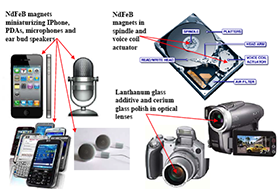![]() Rare Earth: Insights and Concerns
Rare Earth: Insights and Concerns
PIs: Dylan A. Hazelwood and D.K. Anand
Rare earth elements (which are seventeen elements on the periodic table) are used in an ever-growing variety of applications that are key to our modern technology (Fig. 1). In addition they are essential for a wide variety of defense technologies that are critical to national security. Global demand for rare earth materials is projected to grow, fueled in part by continued development and deployment of emerging energy technologies, and as a result, a global shortage of rare earths is anticipated in the near future. Although the United States has 13 percent of the world’s exploitable reserves, nearly all rare earth materials used in the country are imported from China. In contrast, China has only 48.3 percent of the world’s rare earth reserves, yet accounts for more than 97 percent of global rare earth production. Furthermore, China has been reducing its export quotas in order to satisfy growing domestic demand, and is placing further emphasis on strengthening its vertically integrated supply chain in the rare earth industry by focusing on downstream rare earth products.

Overview of uses of rare earth materials in modern electronics
Prices for rare earths experienced a dramatic increase throughout the first half of 2011 – for instance, prices for some key REEs, such as europium and dysprosium, increased by more than eightfold from January to August. Several key factors contributed to this significant increase. An incident in 2010 between Japan and China resulted in rare earth exports to Japan being halted for a month, indicating to the rest of the world that China’s supply could be constrained at any time. During the same period the Chinese government continued to reduce export quotas, and the country’s rare earth producers began to account for the cost of excessive resource exploitation and environmental damage through increases in government taxation.
To address a possible rare earth shortage crisis, the United States needs to actively pursue policies to ensure supply security. In addition to developing domestic resources and stockpiling specific rare earths, we must support the development of new technologies for their mining and processing. We must also develop more efficient manufacturing and recycling methods for consumer goods containing rare earths, investigate synthetic rare earth substitute compounds, and continue research into rare-earth-free technologies.
CECD’s 2012 book Rare Earths: Insights and Concerns was the result of a study performed to create a body of knowledge, and was intended to be a compendium of open literature.Its purpose was to provide timely information in sufficient detail to support the development of appropriate policy decisions, as well as to provide a resource for U.S. commercial concerns. The book provides an insight into the current status of availability, processing and uses of rare earths in the world. Particular attention was given to the role of China, since it is by far the largest provider of these elements worldwide. The status of the U.S. was also reviewed, as were the implications of current and future policies relating to rare earths.

